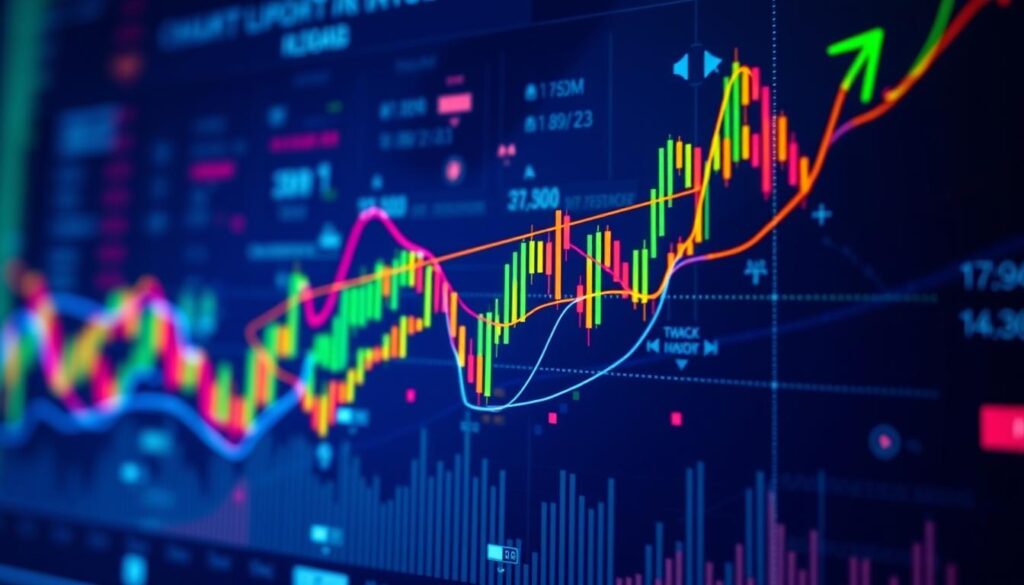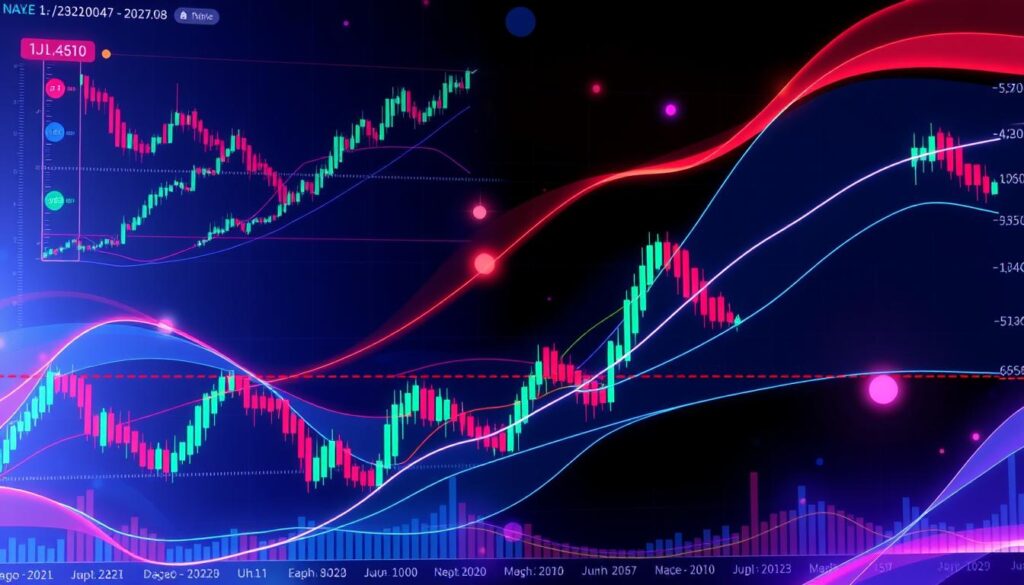Moving averages are a crucial tool in crypto trading, helping traders identify trends and make informed decisions in the volatile cryptocurrency market. By using moving averages, traders can smooth out price fluctuations and generate potential buy and sell signals. In technical analysis, moving averages play a significant role in understanding market trends and patterns. The use of moving averages in crypto trading can be beneficial for identifying short-term and long-term trends, with lower moving averages indicating short-term trends and higher moving averages indicating long-term trends.
Fast Moving Averages like Exponential Moving Average (EMA) and Weighted Moving Average (WMA) are commonly used for short-term trades, while Simple Moving Average (SMA) is used for identifying trends over a specific period. The key to successful crypto trading is to understand how to use moving averages effectively, including calculating SMA, choosing the right timeframes, and combining moving averages with other technical indicators. Moving averages are statistical calculations used to analyze historical prices of cryptocurrencies over specific periods, making them a vital component of technical analysis in crypto trading.
In the world of crypto trading, moving averages can help traders navigate the market and make informed decisions. With the right knowledge and skills, traders can use moving averages to their advantage, identifying trends and generating potential buy and sell signals. Whether you’re a beginner or an experienced trader, understanding how to use moving averages in crypto trading is essential for success. By combining moving averages with other technical indicators and risk management strategies, traders can increase their chances of success in the crypto market.
Table of Contents
Key Takeaways
- Moving averages are a crucial tool in crypto trading for identifying trends and making informed decisions.
- There are different types of moving averages, including Simple Moving Average (SMA), Exponential Moving Average (EMA), and Weighted Moving Average (WMA).
- Moving averages can be used for short-term and long-term trades, with lower moving averages indicating short-term trends and higher moving averages indicating long-term trends.
- Combining moving averages with other technical indicators and risk management strategies can increase the chances of success in crypto trading.
- Understanding how to use moving averages effectively is essential for success in crypto trading.
- Moving averages are statistical calculations used to analyze historical prices of cryptocurrencies over specific periods.
- The use of moving averages in crypto trading can help traders smooth out price fluctuations and generate potential buy and sell signals.
Understanding Moving Averages in Crypto Trading
Moving averages are a crucial tool in crypto market analysis, helping traders identify trends and make informed decisions. By smoothing out price data, moving averages enable traders to focus on the underlying trend, rather than being distracted by short-term fluctuations. This is particularly important in crypto trading, where prices can be highly volatile.
In crypto market analysis, moving averages are used to identify potential support and resistance levels. Traders use moving averages to determine the direction of the trend and to identify potential buy and sell signals. There are several types of moving averages, including the Simple Moving Average (SMA) and the Exponential Moving Average (EMA). Each type of moving average has its own strengths and weaknesses, and traders often use a combination of both to form a complete view of the market.
What is a moving average?
A moving average is a lagging indicator that is based on past prices. It is calculated by summing the closing prices over a certain period and dividing by the number of periods. For example, a 50-day moving average would be calculated by summing the closing prices of the past 50 days and dividing by 50. Moving averages can be used to identify trends, and they are often used in combination with other technical indicators, such as the Relative Strength Index (RSI) or Bollinger Bands.
Why moving averages matter in cryptocurrency markets
Moving averages matter in cryptocurrency markets because they provide a way to identify trends and make informed decisions. By using moving averages, traders can identify potential support and resistance levels, and they can determine the direction of the trend. Moving averages are also useful for identifying potential buy and sell signals, and they can be used to confirm other technical indicators. In trend identification, moving averages play a crucial role, as they help traders to distinguish between short-term fluctuations and long-term trends.
The psychology behind moving average indicators
The psychology behind moving average indicators is that they provide a way for traders to simplify complex market data and make informed decisions. By using moving averages, traders can focus on the underlying trend, rather than being distracted by short-term fluctuations. This can help to reduce stress and increase confidence, as traders are able to make more informed decisions. Additionally, moving averages can be used to identify potential support and resistance levels, which can help traders to develop a trading strategy that is based on trend identification and crypto market analysis.
| Type of Moving Average | Calculation | Use |
|---|---|---|
| Simple Moving Average (SMA) | SMA = (A1 + A2 +… + AN) / N | Identifying trends and support/resistance levels |
| Exponential Moving Average (EMA) | EMA = (TP * (Smoothing / (1 + Days)) + (EMA_Yesterday * (1 – (Smoothing / (1 + Days))) | Identifying trends and support/resistance levels, with more weight given to recent prices |
Types of Moving Averages for Cryptocurrency Analysis
When it comes to cryptocurrency analysis, moving averages are a crucial tool for traders. There are several types of moving averages, including the simple moving average, exponential moving average, and weighted moving average. Each type has its unique characteristics and is used in different ways to analyze cryptocurrency markets.
The simple moving average is calculated by adding the closing prices of an asset over a specific number of periods and then dividing the sum by that number of periods. For example, a 10-day simple moving average takes the sum of the closing prices over the last 10 days and divides it by 10. This type of moving average is often used to identify trends and smooth out price fluctuations.
In contrast, the exponential moving average gives more weight to recent prices, making it more responsive to new information. This type of moving average is often used in conjunction with the simple moving average to identify trends and potential buy and sell signals. The weighted moving average assigns different weights to each data point, with the most recent data points holding the highest weights.
Some key benefits of using moving averages in cryptocurrency analysis include:
- Identifying trends and smoothing out price fluctuations
- Providing support and resistance levels
- Measuring market momentum
By understanding the different types of moving averages and how they are used, traders can make more informed decisions and develop effective trading strategies. Whether using a simple moving average, exponential moving average, or weighted moving average, these tools can help traders navigate the complex world of cryptocurrency markets.
Simple Moving Average (SMA) in Crypto Markets
The Simple Moving Average (SMA) is a widely used indicator in crypto trading, helping traders to identify trends and make informed decisions. SMA calculation involves summing up the prices of a cryptocurrency over a specific period and dividing by the number of periods. This gives equal weight to all data points, providing a clear view of the crypto price trends.
One of the key advantages of SMA is its simplicity and reliability for long-term analysis. By using SMA, traders can filter out noise in asset prices and identify general trends. For example, a 200-day SMA can help traders determine the overall direction of the market, while a 50-day SMA can provide insights into shorter-term trends.
Calculating SMA for Cryptocurrency Pairs
To calculate SMA, traders can use the following formula: SMA = (Sum of prices over a period) / (Number of periods). For instance, the 15-day SMA for a cryptocurrency is calculated by adding up the closing prices over 15 days and dividing by 15.
Best Timeframes for SMA Analysis
The choice of timeframe for SMA analysis depends on the trading strategy. Short-term traders may use a 50-day SMA, while long-term investors may prefer a 200-day SMA. The following table summarizes the most common timeframes used in SMA analysis:
| Timeframe | Description |
|---|---|
| 50-day SMA | Short-term trend analysis |
| 100-day SMA | Medium-term trend analysis |
| 200-day SMA | Long-term trend analysis |
Exponential Moving Average (EMA) Strategy
The Exponential Moving Average (EMA) is a popular trading strategy that gives more weight to recent price data, making it a responsive indicator for short-term trends. The EMA calculation involves the current price, the selected term or number of days for the EMA, and the EMA value of the prior day. This makes the EMA more sensitive to recent price fluctuations, making it ideal for identifying short-term trends.
Traders often use different EMA lengths, such as 10-day, 50-day, and 200-day moving averages, to capture various trends in the market. The 12- and 26-day EMAs are commonly used for short-term analysis, while the 50- and 200-day EMAs are used for long-term trends. The EMA calculation places more weight on the latest data, making it a responsive indicator for recent price changes.
Some common EMA strategies include:
- Using dual EMAs to combine a longer EMA with a shorter-term EMA
- Applying the Moving Average Convergence Divergence (MACD) using the 12-day and 26-day EMAs
- Identifying the “Golden cross” and “Death cross” signals using the 50-day and 200-day EMAs
The EMA strategy is a powerful tool for traders, providing a responsive indicator for short-term trends and a useful tool for identifying entry and exit points in the market. By understanding the EMA calculation and its application in trading, traders can make more informed decisions and improve their trading results.
| EMA Length | Application |
|---|---|
| 10-day EMA | Short-term trading |
| 50-day EMA | Medium-term trading |
| 200-day EMA | Long-term trading |
Setting Up Your Charts for Moving Average Analysis
To effectively use moving averages in crypto trading, it’s essential to set up your charts with the right crypto charting tools. This involves choosing a trading platform that offers customizable charts and a wide range of technical indicators. Popular trading platforms like Cryptorobotics provide various types of moving averages, including Simple Moving Average (SMA), Exponential Moving Average (EMA), and Weighted Moving Average (WMA).
When configuring moving average indicators, it’s crucial to customize timeframes and periods. Typical settings for moving averages include long-term trends (200 days), medium-term trends (50 days), and short-term trends (9, 10, and 20 days). Traders often use a combination of short-term and long-term moving averages to identify trends in crypto trading. By using the right technical analysis setup, traders can make informed decisions and improve their trading strategies.
Here are some key considerations when setting up your charts:
- Choose a trading platform that offers customizable charts and technical indicators
- Configure moving average indicators with the right timeframes and periods
- Use a combination of short-term and long-term moving averages to identify trends
By following these steps and using the right crypto charting tools, traders can set up their charts for effective moving average analysis and improve their trading strategies. With the right technical analysis setup and trading platforms, traders can make informed decisions and achieve their trading goals.
| Moving Average Type | Timeframe | Period |
|---|---|---|
| Simple Moving Average (SMA) | Long-term | 200 days |
| Exponential Moving Average (EMA) | Medium-term | 50 days |
| Weighted Moving Average (WMA) | Short-term | 9, 10, and 20 days |
Popular Moving Average Trading Signals
Trading signals generated by moving averages are a crucial tool for traders, providing buy and sell indicators that can help identify potential trend reversals. The most common moving averages used by traders include the 50-day and 200-day moving averages, which can be used to generate trading signals when they intersect.
A bullish crossover is typically seen when the 50-day Simple Moving Average (SMA) surpasses the 200-day SMA, indicating an upward trend. On the other hand, a bearish crossover occurs when the 50-day Moving Average falls below the 200-day Moving Average, pointing towards a downward trend. These trading signals can be used to inform investment decisions and generate automated buy and sell indicators.
Some popular moving average trading signals include:
- The Golden Cross: a bullish signal that occurs when the 50-day MA crosses above the 200-day MA
- The Death Cross: a bearish signal that occurs when the 50-day MA crosses below the 200-day MA
These signals can be used in conjunction with other technical indicators to form a comprehensive trading strategy, helping traders to identify potentialtrend reversalsand make informed investment decisions.
Moving Average Crossover Strategies
MA crossovers are a popular trading strategy used to identify potential market entry and exit points. This strategy involves the crossing of two or more moving averages to generate buy or sell signals.
A trading strategy using MA crossovers can be effective in identifying trends and making informed decisions. For example, when a shorter-term moving average crosses above a longer-term moving average, it can be a bullish signal, indicating a potential market entry point.
Some common MA crossovers used in trading include the Golden Cross and Death Cross. The Golden Cross occurs when the 50-day moving average crosses above the 200-day moving average, while the Death Cross occurs when the 50-day moving average crosses below the 200-day moving average.
To trade MA crossovers effectively, it’s essential to combine them with other technical indicators and risk management techniques. This can include setting stop-loss orders and adjusting position sizes based on market conditions.
- Use multiple moving averages to generate more robust signals
- Combine MA crossovers with other technical indicators, such as the Relative Strength Index (RSI) or Bollinger Bands
- Adjust your position sizes based on market conditions and risk management techniques
| MA Crossover | Signal | Market Entry/Exit |
|---|---|---|
| Golden Cross | Bullish | Buy |
| Death Cross | Bearish | Sell |
Using Moving Averages as Dynamic Support and Resistance
Traders often use moving averages as dynamic support and resistance levels in the forex market, and this concept also applies to cryptocurrency trading. The use of moving averages can help traders identify key support or resistance points, which is crucial in understanding price levels and trend strength. By analyzing how prices interact with moving averages, traders can gain insights into market psychology and make more informed decisions.
A key aspect of using moving averages as dynamic support and resistance is understanding how they can act as price floors or ceilings. For example, a long-term moving average like the 200-day MA can serve as a strong support level, while a short-term moving average like the 50-day MA can act as a resistance level. Traders can use this information to identify potential buying or selling opportunities, and to set stop-losses or take-profits accordingly.
Some traders also use two moving averages to create a “zone,” which can help determine buying or selling opportunities. This approach can be particularly effective in trending markets, where moving averages can provide a clear indication of trend strength and price levels. However, it’s essential to remember that moving averages are not foolproof, and prices can sometimes break through them.
Here are some key points to consider when using moving averages as dynamic support and resistance:
- Choose the right moving average period for your trading strategy
- Use multiple moving averages to confirm trends and identify support and resistance levels
- Be aware of the potential for false signals in sideways markets
- Combine moving averages with other technical indicators to form a comprehensive trading strategy
| Moving Average | Period | Usage |
|---|---|---|
| 200-day MA | Long-term | Identify strong support and resistance levels |
| 50-day MA | Medium-term | Determine trend direction and potential buying or selling opportunities |
| 10-day MA | Short-term | Identify short-term trends and potential entry or exit points |
By incorporating moving averages into their trading strategy, traders can gain a deeper understanding of market psychology and trend strength, and make more informed decisions about price levels. Remember to always combine moving averages with other technical indicators and to stay adaptable in changing market conditions.
Combining Moving Averages with Other Technical Indicators
When it comes to technical analysis, combining moving averages with other indicators can provide a more comprehensive analysis and help confirm trading signals. By using indicator combinations, traders can gain a deeper understanding of market trends and make more informed decisions.
A comprehensive analysis involves using multiple indicators from different categories, such as trend following indicators, momentum indicators, volume indicators, and volatility indicators. For example, combining a moving average with the Relative Strength Index (RSI) can help traders identify overbought and oversold conditions, while also providing trading signals confirmation.
Some popular indicator combinations include:
- Moving Average Convergence Divergence (MACD) and MESA
- RSI and moving averages
- Volume analysis with moving averages
- Bollinger Bands integration
These combinations can help traders identify potential breakouts, trend reversals, and entry and exit points, ultimately leading to more effective trading strategies.
By using these indicator combinations and conducting a comprehensive analysis, traders can gain a competitive edge in the market and make more profitable trades. Remember to always use multiple indicators to build a more reliable trading strategy and to continuously monitor and adjust your approach as market conditions change.
| Indicator Combination | Description |
|---|---|
| MACD and MESA | Used to identify buy and sell signals, with MESA serving as a filter for MACD signals |
| RSI and moving averages | Used to identify overbought and oversold conditions, with moving averages providing trading signals confirmation |
| Volume analysis with moving averages | Used to confirm or contradict moving average signals, with volume analysis providing additional insights |
| Bollinger Bands integration | Used to identify potential breakouts and trend reversals, with Bollinger Bands providing a volatility-based perspective |
Risk Management When Trading with Moving Averages
Effective risk management is crucial when trading with moving averages in the cryptocurrency market. This involves stop-loss placement, which helps limit potential losses. By setting a stop-loss order based on a moving average level, traders can manage their risk and protect their capital.
Another important aspect of risk management is position sizing. This involves determining the appropriate trade size based on the trader’s account balance and risk tolerance. By adjusting the position size, traders can manage their risk and avoid significant losses.
In highly volatile markets, volatility management is essential. This involves adjusting the trading strategy to account for the increased volatility, such as using tighter stop-loss levels or reducing the position size. By managing volatility, traders can reduce their risk and increase their potential for profit.
Some key considerations for risk management when trading with moving averages include:
- Setting stop-loss levels based on moving average levels
- Adjusting position size based on account balance and risk tolerance
- Managing volatility through adjustments to the trading strategy
By incorporating these risk management strategies into their trading plan, traders can effectively manage their risk and increase their potential for success in the cryptocurrency market.
| Risk Management Strategy | Description |
|---|---|
| Stop-Loss Placement | Setting a stop-loss order based on a moving average level |
| Position Sizing | Determining the appropriate trade size based on account balance and risk tolerance |
| Volatility Management | Adjusting the trading strategy to account for increased volatility |
Common Moving Average Trading Mistakes to Avoid
When using moving averages in crypto trading, it’s essential to be aware of common trading pitfalls that can negatively impact your strategy. One of the primary mistakes is over-relying on a single indicator, which can lead to a lack of market awareness. To avoid this, traders should combine moving averages with other technical indicators to optimize their strategy optimization.
Some common mistakes in moving average trading include:
- Ignoring other indicators and solely relying on moving averages
- Using inappropriate timeframes, which can lead to false signals
- Not adapting to changing market conditions
- Overtrading based on minor moving average fluctuations
To refine your moving average strategy and avoid these mistakes, it’s crucial to regularly assess your approach and make adjustments as needed. This includes backtesting your strategy using historical data and incorporating other technical indicators to enhance market awareness. By being aware of these common trading pitfalls and taking steps to avoid them, you can optimize your strategy optimization and improve your overall trading performance.
By combining moving averages with other technical indicators and staying informed about market conditions, you can create a well-rounded trading strategy that helps you navigate the complexities of the crypto market and achieve your trading goals.
| Mistake | Impact | Solution |
|---|---|---|
| Over-relying on a single indicator | Lack of market awareness | Combine moving averages with other technical indicators |
| Using inappropriate timeframes | False signals | Adjust timeframes based on trading objectives |
| Not adapting to changing market conditions | Reduced accuracy | Regularly assess and adjust strategy |
Advanced Moving Average Trading Techniques
For traders looking to refine their strategies, advanced moving average techniques can provide a competitive edge. These sophisticated strategies involve using adaptive moving averages, such as Kaufman’s Adaptive Moving Average (KAMA), to adjust to market volatility. By combining moving averages with momentum indicators, traders can create more effective trading signals.
Professional trading often involves analyzing market efficiency to identify trending or ranging markets. Moving averages can be used to analyze market efficiency, helping traders make informed decisions. Some common techniques include using multiple timeframe analysis and advanced crossover strategies, such as using three moving averages to generate precise signals.
Some popular moving averages used in advanced trading strategies include:
- Smoothed Moving Average (SMMA)
- Linear Weighted Moving Average (LWMA)
- Double Exponential Moving Average (DEMA)
These moving averages can be used in combination with other indicators to create sophisticated strategies. By understanding how to use these advanced techniques, traders can improve their trading results and stay ahead of the competition.
Ultimately, the key to successful trading is to find a strategy that works for you and to continually refine and adapt it to changing market conditions. By incorporating advanced moving average techniques into your trading strategy, you can take your trading to the next level and achieve greater market efficiency.
| Moving Average | Description |
|---|---|
| Simple Moving Average (SMA) | Average price over a specified period |
| Exponential Moving Average (EMA) | Weighted average with more recent prices given more weight |
| Kaufman’s Adaptive Moving Average (KAMA) | Adaptive average that adjusts to market volatility |
Real-World Examples of Successful Moving Average Trades
When it comes to trade analysis, moving averages can be a powerful tool for identifying market patterns and informing successful strategies. By examining historical price charts, traders can see how different moving average strategies could have been applied for profitable trades.
A key aspect of trade analysis is understanding how moving averages can be used to identify trends and generate trading signals. For example, a Golden Cross occurs when a short-term moving average crosses above a long-term moving average, indicating a potential bullish trend. This can be a useful signal for traders looking to inform their market patterns and develop successful strategies.
Some notable examples of successful moving average trades include:
- Bitcoin’s Golden Cross in early 2023, which led to a notable bullish trend
- Ethereum’s Golden Cross in the summer of 2023, which resulted in an uptrend
- Litecoin’s strong bullish trend in mid-2023, identified using a 20-day Weighted Moving Average
By analyzing these examples and understanding how moving averages can be used to identify market patterns, traders can develop their own successful strategies and improve their trade analysis.
Creating Your Personal Moving Average Trading Strategy
To develop a successful moving average trading strategy, it’s essential to start with strategy development, considering your risk tolerance, available trading time, and overall goals. This process involves selecting appropriate moving averages and timeframes based on these personal factors. For instance, the combination of five-, eight-, and 13-period simple moving averages (SMAs) can be a robust way to find trading prospects.
A crucial step in backtesting is to use historical data to evaluate the potential effectiveness of a strategy. This can help identify the best timeframes and moving averages for your trading goals. For example, the first leg of an uptrend using the 5-8-13 SMA combination lasted 51 five-minute bars and generated 2.59 points or 0.79% without considering spreads and commissions.
Once you’ve developed and backtested your strategy, it’s essential to focus on performance optimization. This can involve adjusting entry and exit criteria or combining moving averages with other indicators. By continually refining your strategy and adapting to changing market conditions, you can improve your trading performance and achieve your goals.
Some key considerations for optimizing your strategy include:
- Recognizing trendless markets and staying on the sidelines when necessary
- Identifying high-volatility periods and adjusting your strategy accordingly
- Using multiple moving averages and technical indicators to confirm trading signals
By following these steps and continually refining your strategy, you can create a personalized moving average trading strategy that helps you achieve your trading goals.
| Strategy | Timeframe | Performance |
|---|---|---|
| 5-8-13 SMA combination | 5-minute bars | 2.59 points or 0.79% |
| Exponential moving average | Short-term | Mean-reversion strategy |
Conclusion
As we’ve explored, trading skills and continuous learning are essential for navigating the dynamic cryptocurrency markets. Moving averages have proven to be powerful tools in the traders’ arsenal, providing valuable insights into market market adaptation and trend identification.
From the simple SMA to the more sophisticated EMA and DEMA, we’ve discussed the nuances of these technical indicators and how they can be effectively integrated into a comprehensive trading strategy. Remember, while moving averages are incredibly useful, they should not be relied upon as standalone decision-makers. Instead, combine them with other indicators, analyze market context, and always prioritize sound risk management practices.
The journey of mastering crypto trading is an ongoing one, filled with both triumphs and challenges. Stay curious, stay adaptable, and never stop expanding your knowledge. By continuously refining your skills and staying attuned to market changes, you’ll be well-positioned to navigate the volatile cryptocurrency landscape and capitalize on emerging opportunities.
FAQ
What are moving averages and how do they work in crypto trading?
Moving averages are a technical analysis tool that smooths out price fluctuations to identify trends in the cryptocurrency market. They calculate the average price over a specific timeframe, helping traders make informed decisions by identifying potential buy and sell signals.
Why are moving averages important for crypto traders?
Moving averages are important in crypto trading because they can help identify market trends, provide dynamic support and resistance levels, and generate potential buy and sell signals. They are a widely used indicator that can help traders navigate the volatility of the cryptocurrency markets.
What are the different types of moving averages used in crypto analysis?
The three main types of moving averages used in crypto trading are the Simple Moving Average (SMA), Exponential Moving Average (EMA), and Weighted Moving Average (WMA). Each type has its own unique characteristics and is suited for different trading strategies and market conditions.
How do I calculate and use a Simple Moving Average (SMA) in crypto trading?
To calculate an SMA for a cryptocurrency pair, you need to add up the closing prices for a specific number of periods (e.g., 20 days) and divide the sum by the number of periods. SMA is useful for identifying long-term trends and can be applied to various timeframes to suit different trading strategies.
What are the benefits and limitations of using Exponential Moving Averages (EMAs) in crypto trading?
EMAs place more weight on recent price data, making them more responsive to current market conditions than SMAs. EMAs are particularly useful for short-term trading strategies, as they can quickly adapt to changes in price trends. However, EMAs may be more susceptible to false signals in volatile markets.
How can I set up my charts for effective moving average analysis in crypto trading?
Setting up your charts for moving average analysis involves choosing the right trading platform with customizable charts and technical indicators, configuring the moving average indicators, and selecting the appropriate timeframes and periods to suit your trading style and strategy.
What are the most common moving average trading signals in crypto markets?
Some of the most popular moving average trading signals include crossovers (like the Golden Cross and Death Cross), price crosses, and divergences. These signals can indicate potential trend changes, reversals, or continuation, and should be used in conjunction with other technical and fundamental analysis to confirm trading decisions.
How can I use moving average crossover strategies in crypto trading?
Moving average crossover strategies, such as the Golden Cross and Death Cross, can be used to identify major trend changes in the cryptocurrency market. By combining different moving average timeframes, traders can generate more robust buy and sell signals, but should also be aware of the limitations of these strategies in volatile or choppy market conditions.
How can I use moving averages as dynamic support and resistance levels?
Certain moving averages, particularly longer-term ones like the 50-day or 200-day MA, can act as dynamic support and resistance levels in the crypto market. Traders can use this knowledge to time their entries and exits, placing trades when prices bounce off or break through these key moving average levels.
What are some common mistakes to avoid when using moving averages in crypto trading?
Some common mistakes include over-relying on a single indicator, using inappropriate timeframes, ignoring market context, and overtrading based on minor moving average fluctuations. It’s important to use moving averages as part of a comprehensive trading strategy and to continuously adapt to changing market conditions.









